MG
|
1924 - Present |
Country: |
 |
|
Cecil Kimber And The Morris Cowley
The story of MG (short for Morris Garages)
naturally begins at Morris Motors, and we need to go
back to 1923 to find the visionary responsible.
Cecil
Kimber, then General Manager for Morris, is credited
by most as pioneer of the MG brand after he instigated
the manufacture of the Morris Cowley.
The Cowley used Morris mechanicals fitted to a close-coupled
four-seater body manufactured by "Carbodies" of Coventry.
The Cowley quickly became a Morris success story, and
so the factory naturally began the manufacture of their
own body very similar to the Cowley.
But
Kimber was
still keen to test the boundaries of design and innovation
(and the publics acceptance of these type of vehicles),
and he then turned to Raworth of Oxford to produce six
two-seater tourers, followed by a small series of four-door
saloons based on the Morris Oxford chassis.
When ready for sale, they were advertised in the March
1924 edition of the "Morris Owners Magazine" under the
model designation "MG-V-Front Saloon" - the first recorded
use of the initials "MG". Two months later the slow-selling
Raworth two-seater was advertised as the "MG Super Sports
Morris" - the "MG" brand was quickly becoming established.
The Morris Oxford As A Donor Car
During 1924 the Morris Oxford would again prove to be
a valuable "donor car" when it would be used to form
the basis of a small series of sporting four-seaters
that featured mildly tuned engines, a lower chassis
and aluminium Ace wheel disks covering the 'Artillery'
style wheels of the standard car. Sanctioned by William
Morris (owner of both Morris Motors and Morris Garages),
Kimber's sporty new car would be dubbed the "MG Super
Sports".
Soon every young Englishman wanted to drive Kimber's
sporty derivative of the Morris, and so in 1926 MG moved
to their own separate production facility in North Oxford
- which is where the first production MG would be manufactured,
the 14/40 (although it would still use a standard Morris
chassis frame).
The 14/40 offered firmer suspension
than its touring cousin, a special back axle, and a
tuned-up side-valve 1.8 litre Morris engine. The maximum
speed of the 14/40 was approximately 65mph, though the
cars cruising speed was only 5 mph slower at 60mph.
And because the car was lightweight (some 2200lb), the
14/40 was able to return the very good petrol consumption
figures of 30mpg.
The Move To Abingdon
Once again MG grew out of its premises, so a move was
made to Edmund Road, not far from the big Morris factory
in Cowley, but even this facility did not last long,
and in 1929 they moved again, to a disused leather factory
at Abingdon, just a few miles south of Oxford itself.
In the autumn of 1928, however, MG had introduced two
new models.
The first was the 18/80 model, entirely
different from anything that had gone before. Only the
engine remained Morris, and even this was a 2468cc six-cylinder
overhead-cam design produced at Hotchkiss with MG in
mind! It was also intended for use in Morris Light Six,
Six and Isis models of the late 1920's, but these cars
all suffered from a poor chassis and roadholding and
were perhaps not deserving of the new motor.
For use in MG's, the Morris engine was tuned up and
fitted with twin
SU carburettors; while "Rudge-Whitworth"
centre-lock wire wheels were used for the first time
on a MG. There would be a total of 736 Mk. 1 & 2's manufactured
up until 1933. But 1928 is perhaps better remembered
as the year MG released the car that would instigate
large scale production and ultimately ensure the success
of the marque - the all-new "M-Type" Midget.
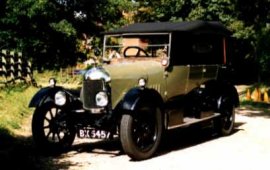 With mechanicals by Morris
and a body by "Carbodies" of Coventry,
the Cowley began the MG marque...
With mechanicals by Morris
and a body by "Carbodies" of Coventry,
the Cowley began the MG marque...
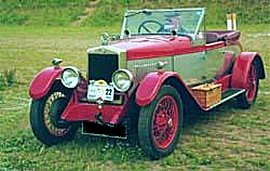
The 14/40 was the first production MG and used
a standard Morris chassis frame...
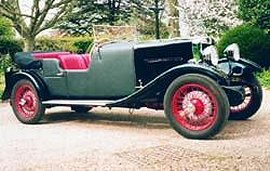
The 1928 18/80 may have used a Morris engine,
but it was tuned up and fitted with twin SU carburettors; while "Rudge-Whitworth" centre-lock
wire wheels were used for the first time...
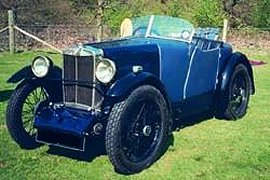
The 1928 M-Type Midget would herald the beginning
of large scale production at MG...
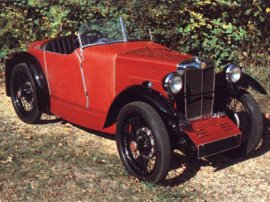
The Midget, in tuned form, was the first 760cc
engined car to not only exceed 100mph (161kmh)
but to also cover 100 miles in an hour...
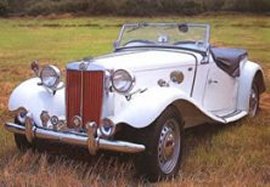 The biggest criticism for
the TD was reserved for the steel wheels, MG
opting not to use the far prettier "wire
wheels"...
The biggest criticism for
the TD was reserved for the steel wheels, MG
opting not to use the far prettier "wire
wheels"...
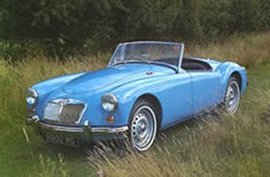 The MGA would have to wait
3 years to make it into production with new
owners BMC favouring the Austin-Healey 100...
The MGA would have to wait
3 years to make it into production with new
owners BMC favouring the Austin-Healey 100...
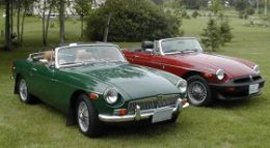 Very little changed during
the production life of the MGB, although many
thought the "Rubber Nose" versions
(required to meet US safety requirements) turned
the pretty into pretty ugly...
Very little changed during
the production life of the MGB, although many
thought the "Rubber Nose" versions
(required to meet US safety requirements) turned
the pretty into pretty ugly...
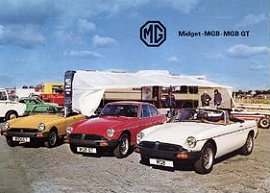 The 1977 lineup of MG's,
the Midget, MGB and MGB GT (pictured centre)...
The 1977 lineup of MG's,
the Midget, MGB and MGB GT (pictured centre)...
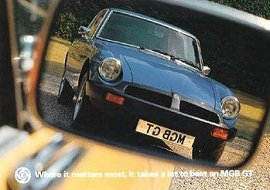 Even though it's a "Rubber-Nose",
the GT is very collectable...
Even though it's a "Rubber-Nose",
the GT is very collectable...
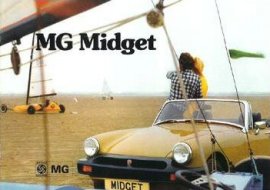 More an exercise in badge-engineering,
some 226,526 Austin-Healey Sprite derived MG
Midgets would be manufactured...
More an exercise in badge-engineering,
some 226,526 Austin-Healey Sprite derived MG
Midgets would be manufactured...
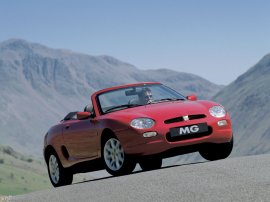
Like a phoenix rising from the ashes, MG would
release the "MGF" - a great car, but apparently not good enough to save the company... |
Birth Of The Midget's
Once again a Morris chassis and running gear would be
used, this time borrowed from the Morris Minor, however
it would use the Wolseley designed 847cc 4 cylinder
SOHC engine producing a meagre 20bhp. Nevertheless the
Midget would prove a rather brisk drive, as the engine
only had to propel an 1100lb car (combined of course
with the driver and passengers weight).
Subsequent developments
of the engine include the use of a 746cc engine for
competition use in the 750cc class - its rival the Austin
Seven, and for the "Montlhery" derivative this could
be supplied in normal, or Powerplus supercharged form.
The blown cars produced up to 60bhp making it good for
around 90mph flat out. Later cars of all types had different
body styles, some with pointed tails, and light metal
panelling. After a four year run, the "M-Type" (or 8/33
as it had also been dubbed) , was dropped in favour
of the 1932 J2 Midget, which was the epitome of a style
so typical of all British sports-cars of that era. The
slim shell used cutaway doors, a slab fuel tank, and
the spare wheel was mounted on the tail.
There was a rare J1 saloon version, and two special
super-charged racing versions known as J3 and J4. However
from early 1934 the J2 gave way to more sophisticated
"P-Type" (later known as the PA) Midget, which had a
more flowing style and added creature comforts. Like
all other MG's of the period, it used a single overhead
camshaft engine, rock hard leaf spring suspension, and
a 'crash' (non-synchromesh) gearbox.
The last in this series of cars was the PB, introduced
in 1935, which had an enlarged (939cc) engine producing
43bhp at 5500rpm. Once again the engine was sourced
from Wolseley, although it would undergo specific "MG"
modification - strangely something MG went to great
lengths to disguise! Racing Midgets gained many competition
successes, for
Kimber was very keen on this activity
as a way of publicizing and improving the breed.
In 1930, for instance, the MG team took the team prize
in the JCC Double-twelve (hour) race at
Brooklands,
while in the same race in 1931 they took the first six
places in their class and won the race outright on handicap.
A Midget also won the Irish Grand Prix, and the Tourist
Trophy race in 1931, and in 1932 cars took the team
prize and class victory, and outright victory for R
T Horton's special-bodied car at 96.29mph.
The Midget, in tuned form, was also the first 760cc
engined car to not only exceed 100mph but to also cover
100 miles in an hour. While the focus for MG may have
been on the Midget, they were also busy building a small
six-cylinder-engine range. In 1931 the F-Type Magna
debuted, and featured a 37bhp version of the Wolseley
Hornet engine (Morris had owned Wolseley since 1927).
This 1271cc engine featured overhead-camshaft valve
gear, and was put to good use in the elegant four-seater
sports body - although the Magna was only good for a
top speed of around 70mph. It would be superseded in 1933 by the L-Type Magna,
which used a more specialized engine featuring a cross-flow
cylinder head with the carburettors situated on the
right.
The K-Type Magnette's
The K-Type Magnette series arrived in 1932, with
the original K1 and later K2 cars being sold with open
and closed body styles and using the original 1271cc
engine. 1933 would see the release of the K3 sports
car - which would quickly rise to glory in the racing
world and would be powered instead by a short-stroke
1087cc engine.
The K1 and K2's would be phased out in 1934 in favour
of the new N-Type Magnettes, their main advantage being
a healthy upgrade in power, from 41 and 48bhp (K1 &
K2 respectively) to a very healthy 57bhp. The K3's greatest
claim to fame was in an outright victory in the 1933
Tourist Trophy race on the "Ards" circuit in Northern
Ireland when driven by the great
Tazio Nuvolari.
It
had a powerful supercharged version of the 1087cc engine,
and was fitted with a preselector transmission. In stripped
out form a K3 was even competitive for single-seater
racing car events - Whitney Straight winning the Coppa
Acerbo Junior event of 1933, against single-seater Maseratis
on their home ground. Only 33 K3's were built, and these
were followed by 10 single-seater R-Type models, which
had a backbone chassis frame, all-independent suspension,
and supercharged 746cc engines.
In 1935 there were corporate changes at Morris Motors,
and in the wash up both Wolseley and MG were taken into
direct control of Morris. The Abingdon design department
was closed down, and so for mid-1936 it was up to the
Cowley design department to produce the new TA Midget.
Many claim the TA was a "softer" car that its forebears,
and even though the new MG tuned 1292cc engine (borrowed
from the Wolseley 10/40) had greater power output, it
did not rev freely and therefore removed a little of
the sporting character so evident in the K series Magnettes.
But many would have forgiven the new MG its sins when,
at last, the gearbox featured
synchromesh on the upper
ratios. In 1939 the TA became TB, with the aid of a
new type of short-stroke 1250cc engine (basically that
of the new Morris 10 'M'), and it is assumed that the
new MG would have gone on to sell well - but alas the
war would intervene.
Almost all TA's and TB's were traditionally-styled
open two seaters, though there was also the option of
a coach-built Tickford model, with wind-up door glass
and a fold-down hood. In 1945 (and following the end
of WWII), MG restarted production with the TC sports-car,
it being a very lightly modified TB.
Making An MG That Appealed To Americans
And although the
TC was produced only in right-hand-drive, it introduced
MG to the important US market. Some 10,000 TC's were
manufactured up to the end of 1949, with many finding
their way into competition work. So MG had the makings of a US success story on their
hands with the TC, but feedback showed the American
buyer expected more comfort than it currently offered,
and certainly the looks appeared a little dated.
With
that in mind, the design team came up the
1950 model
TD featuring a new box-section chassis frame, with coil
spring independent front suspension, rack and pinion
steering, and a hypoid-bevel rear axle, plus a more
spacious, but still traditionally-styled, body. Obviously
left hand drive versions were manufactured, but MG would
not supply the cars with wire-spoke wheels.
Nevertheless sales would boom, with 1952 being the best
year for the TD and around 90 per cent of manufactured
cars being exported, and a total of 29,664 being manufactured
in four years. During the reign of the TD MG would become
part of the Nuffield organization, which in turn would
be swallowed up by British Motor Corporation. Although a replacement for the TD was designed (this
would become the MGA in later years), the heads of BMC
favoured the new Austin-Healey 100, and only allocated
funding for a further freshen-up of the TD design.
The
subsequent TF model was hurriedly produced for the autumn
of 1953 but was somewhat of a disappointment, using
the aging TD chassis and being only capable of around
80mph. The following year the TF would be fitted with
a larger 1466cc engine, but the MG still was found to
be wanting when compared to the likes of the Triumph
TR2. The TF would have its final curtain call in the
spring of 1955.
The Release Of The MGA
And so 1955 saw the release of the car the TF should
have been, the 1952 designed
MGA - and it was an immediate
success. Equipped with a very strong separate chassis
and the TF's front suspension, it used a tuned BMC 1489cc
pushrod overhead valve engine, all presented in a beautiful
sleek and wind cheating all-enveloping body style -
helping it to a top speed of nearly 100mph.
A comfortable
bubble-top fixed head coupe was announced a year later,
and a detachable hardtop was always available.
Triumph fans always knew the MG's were still underpowered,
particularly when compared to the 1991cc TR2 or the
2.6 litre Austin-Healey's. MG knew engine capacity needed
to increase, and so in 1959 capacity jumped to 1588cc,
and the Mk II of 1961 had size increase again to 1622cc.
Despite its power and performance disadvantage when
compared to its rivals, the MGA was a very successful
model and when production came to an end in 1962 over
100,000 had been manufactured. (Interestingly only 5815
would have a UK delivery address). MG had planned an extensive racing program for the MGA,
introducing the
prototype at the 1955 Le Mans. Management
soon shelved the idea following the horrific accident
that year when, some three hours into the race, a Mercedes
300 SLR would collide with an Austin Healey, plunging
the hapless Mercedes into the grandstands.
The crash and
ensuing fire killed the Mercedes SLR's driver and over 80
of the spectators. MG would not be the only manufacturer
to retire from the circuit, with Mercedes-Benz immediately
withdrawing the remainder of their team, even as Sterling
Moss and
Juan Manuel Fangio in their SLR were leading
the top Jaguar D-Type by more than two laps. (
Mike Hawthorn and Ivor Bueb, who were piloting the Jag would go on
to a rather hollow victory). The MGA's consistently clocked 117mph on the straight and were tuned to produce 80bhp.
More Power, Greater Reliability, The MGB
The MGA Twin-Cam was a limited production model (2111
built), with a specially developed twin-overhead camshaft
engine developing 108bhp and featuring four-wheel disc
brakes - however reliability problems would quickly
tarnish its reputation. In 1962 arguably MG's most famous
model would be released, the illustrious MGB. As the
MGA's successor the MGB needed more comfort, power and
even more modern styling - something the MGB had in
spades.
Built on a unit-construction body/chassis design, the
MGA's front suspension and basic engine/drive line were
carried over, however the capacity was upped to 1798cc
and was good for 95bhp and could travel comfortably
over 100mph. At first only a two-seater open sports
version was available, but the very elegant MGB GT hatchback
derivative followed in 1965. An amazingly long-lived
design, the "B" would remain in production until 1980
after a total of 512,880 were built.
It was unfortunate that the design was improved very
little during that time, and the MGB was showing its
age against the competition years before production
would grind to a halt. Two limited-production models
were developed from the MGB. The first was the MGC of
1967/69, which used a six-cylinder overhead valve 145bhp
engine developed from the Austin 3 litre saloon. Unfortunately
the torsion bar front suspension produced way too much
understeer, and was dropped after only 8999 had been
built.
The MGB GT V8
The better of the two was the now highly prized MGB
GT V8 of 1973/76, however its enemy was the cost, with
only 2591 customers prepared to fork out the sticker
price. Based on the GT hatchback body, it was equipped
with the 137bhp version of the Rover (ex-GM) light-alloy
V8 engine. Powerful, fast (good for over 125mph) and
very refined, it was produced five years too late, for
MG and Rover had been linked (in British Leyland) since
1968.
The four-cylinder MGB was a very successful long-distance
racing sports-car, putting in three appearances at Le
Mans, and winning its class in 1963 with an average
92mph - which was subsequently improved upon in 1965
when the average jumped to 98.26mph. Also worth mentioning is the irrepressible Midget, manufactured
between 1961 and 1979. Although more an exercise in
badge-engineering, some 226,526 Austin-Healey Sprite
derived MG Midgets would be manufactured, and from late
1974, a Triumph Spitfire 1491cc/65bhp engine would be
used.
While the latter upgrade was lamented by purists,
it did give the mighty Midget a genuine top speed over
100mph. Under British Leyland management, MG would be
persistently neglected in favour of Triumph, and so
with no further development the existing MGB and Midget
were destined to have an ignominious end.
That it would take so long for these models to eventually
die off is testament to the cars looks, style, grace
and performance. The MG badge would be resurrected with
subsequent Metro, Maestro and Montego models, although
the Abingdon spirit and allure of the Morris Garages
emblem had been lost - it would seem - for ever. But
then, like a phoenix rising from the ashes, MG would
release the "MGF" - a great car, but seemingly not good enough to save the company.
Also see: The MG Story |
MG Car Reviews |
Sprites and Midgets 


